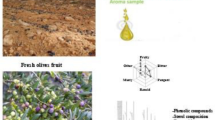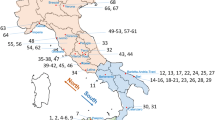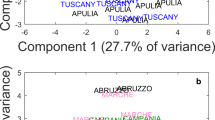Abstract
Polar compounds of virgin olive oils were analyzed. They influence oil flavor and aroma and improve the shelf-life of the oil. The orthodiphenolic fraction is particularly significant for oil stability because of its antioxidative activity. A relationship between the composition of the whole fraction of polar compounds and the state of health of the olives was established. For this purpose, oil samples were obtained from olives that had reached different degrees of ripeness and that had been affected by Dacus oleae infestation differently. The polar compounds were then analyzed by high-performance liquid chromatography. The data set was studied by means of chemometric methods. Partial least squares regression was used to obtain models that show a significant correlation between composition of the oil’s polar compounds and conditions of the olives sampled. In particular, compounds with antioxidative activity were directly linked with the state of health of the olives. The models obtained allow tracing of the state of health of the olives sampled through analysis of the polar fraction of virgin olive oil with a high degree of accuracy, and thus prediction of the oil’s expected shelf life.
Similar content being viewed by others
References
Vasquez Roncero, A., Les Polyphénoles de l’Huile d’Olive et Leurs Influence sur les Caractéristiques de l’Huile, Rev. Franç. Corps Gras 25:21–26 (1978).
Solinas, M., A. Di Giovacchino, and A. Mascolo, The Polyphenols of Olives and Olive Oil. Note III. Influence of Temperature and Kneading Time on the Oil Polyphenols Content, Riv. Ital. Sost. Grasse 55:19–23 (1978).
Graciani Constante, E., and A. Vasquez Roncero, Study on Polar Components of Olive Oil by High-Performance Liquid Chromatography (HPLC). Application to Various Types of Virgin Oils, Grasas Aceites 32:365–371 (1981).
Perrin, J.L., Les Composés Mineurs et les Antooxygènes Naturels de l’Olive et de Son Huile, Rev. Franç. Corps Gras 39:25–32 (1992).
Gutierrez Gonzales-Quijan, R., C. Janer del Valle, M.L. Janer del Valle, F. Gutierrez Rosales, and A. Vasquez Roncero, Relationship Between Polyphenols Content and the Quality and Stability of Virgin Olive Oil, Grasas Aceites 28:101–106 (1977).
Cortesi, N., A. Ponziani, and E. Fedeli, Characterization of Virgin and Refined Olive Oils by HPLC of Polar Component, Riv. Ital. Sost. Grasse 58:108–114 (1981).
Di Giovacchino, L., M. Solinas, and M. Miccoli, Effect of Extraction Systems on the Quality of Virgin Olive Oil, J. Am. Oil Chem. Soc. 71:1189–1193 (1994).
Maestro-Durán, R., R. León Cabello, and V. Ruiz Gutíerrez, Phenolic Compounds from Olive (Olea europaea), Grasas Aceites 45:265–269 (1994).
Cortesi, N., and E. Fedeli, Polar Components of Virgin Olive Oil. Note 1, Riv. Ital. Sost. Grasse 60:341–351 (1983).
Amiot, M.T., A. Fleuriet, and J.T. Macheix, Importance and Evolution of Phenolics Compounds During Growth and Maturation, J. Agric. Food Chem. 34:823–826 (1986).
Maestro Durán, R., and R. Borja Padilla, Relationship Between the Quality of the Oil and the Composition and Ripening of the Olive, Grasas Aceites 41:171–178 (1990).
Evangelisti, F., P. Zunin, E. Tiscornia, and R. Petacchi, Effect of Different Environmental and Cropping Conditions on the Antioxidant Compounds of Virgin Olive Oil, in Proceedings of the Second National Conference on Food Chemistry, Grafica Ed., Messina, 1995, pp. 519–523.
Evangelisti, F., P. Zunin, C. Calcagno, E. Tiscornia, and R. Petacchi, Dacus oleae Infestation and Its Consequences on the Phenolic Compounds of Virgin Olive Oil, Riv. Ital. Sost. Grasse 71:507–511 (1994).
Zunin, P., F. Evangelisti, M.A. Pagano, E. Tiscornia, and R. Petacchi, Phenolic Compounds in Oil Obtained from Olea europaea and Anti-Dacus Treatments, Ibid.:55–59 (1995).
Solinas, M., A. Di Giovacchino, and A. Mascolo, The Polyphenols of Olives and Olive Oil. Note IV. Their Evolution Depending by Early Oxidative Reactions Which Happened During the Storage of the Oil, Ann. Ist. Sper. Elaiotecn. 8:3–19 (1978).
Chimi, H., A. Sadik, B. Le Tutour, and M. Rahmani, Contribution à l’Étude Comparative des Pouvoirs Antioxydants dans l’Huile d’Olive du Tyrosol, de l’Hydroxytyrosol, de l’Acide Cafeique, de l’Oleuropéine et du BHT, Rev. Franç. Corps Gras 35:339–344 (1988).
Chimi, H., M. Rahmani, J. Cillard, and P. Cillard, Autooxydation des Huiles d’Olive: Rôle des Composés Phenoliques, Ibid.:363–367 (1990).
Papadopoulos, G., and D. Boskou, Antioxidant Effect of Natural Phenols on Olive Oil, J. Am. Oil Chem. Soc. 68:669–671 (1991).
Armanino, C., R. Leardi, and S. Lanteri, Chemometric Analysis of Tuscan Olive Oils, Chemom. Intell. Lab. Syst. 5:343–354 (1989).
Aparicio, R., L. Ferreiro, R. Leardi, and M. Forina, Building Decision Rules by Chemometric Analysis: Application to Olive Oil, Ibid.:349–358 (1991).
Alessandri, S., A. Cimato, A. Mattei, and G. Modi, Characterization of Olive Oils from Tuscany According to Harvesting Time, by Means of Their Phenols Content, Boll. Chim. Igien. 43:143–161 (1992).
Montedoro, G.F., M. Servili, M. Baldioli, C. Magnarini, L. Cossignani, and P. Damiani, Potential Models Defining Virgin Olive Oil Characteristics, Ind. Alim. 32:618–631 (1993).
Drava, G., M. Forina, S. Lanteri, and M. Lupoli, Development of the Chemical Model of a Typical Food Product: Olive Oil from an Italian Region (Basilicata), J. Sci. Food Agric. 65:21–30 (1994).
Baraldi, P.G., D. Simoni, S. Manfredini, and E. Menziani, Preparation of 3,4-Dihydroxy-1-Benzenethanol: A Reinvestigation, Liebigs Ann. Chem.: 684–686 (1983).
Forina, M., R. Leardi, C. Armanino, and S. Lanteri, QPARVUS: An Extendable Package of Programs for Data Exploration, Classification and Correlation, Istituto di Analisi e Tecnologie Farmaceutiche e Alimentari, Università di Genova, 1995.
Meloun, M., J. Militky, and M. Forina, Exploratory and Factor Analysis of Multivariate Data, in Chemometrics for Analytical Chemistry, Vol. 1, Ellis Horwood, New York, 1992, pp. 212–300.
Brown, P.J., Measurement, Regression, and Calibration, Oxford University Press Inc., New York, 1993, pp. 51–117.
Montedoro, G.F., M. Servili, M. Baldioli, R. Selvaggini, E. Miniati, and A. Macchioni, Simple and Hydrolyzable Compounds in Virgin Olive Oil. 3. Spectroscopic Characterization of the Secoiridoid Derivatives, J. Agric. Food Chem. 41:2228–2234 (1993).
Saxberg, B.E.H., D.L. Duewer, J.L. Booker, and B.R. Kowalski, Pattern Recognition and Blind Assay Techniques Applied to Forensic Separation of Whiskies, Anal. Chim. Acta 103:201–212 (1978).
Author information
Authors and Affiliations
Corresponding author
About this article
Cite this article
Evangelisti, F., Zunin, P., Tiscornia, E. et al. Stability to oxidation of virgin olive oils as related to olive conditions: Study of polar compounds by chemometric methods. J Amer Oil Chem Soc 74, 1017–1023 (1997). https://doi.org/10.1007/s11746-997-0019-y
Received:
Accepted:
Issue Date:
DOI: https://doi.org/10.1007/s11746-997-0019-y




